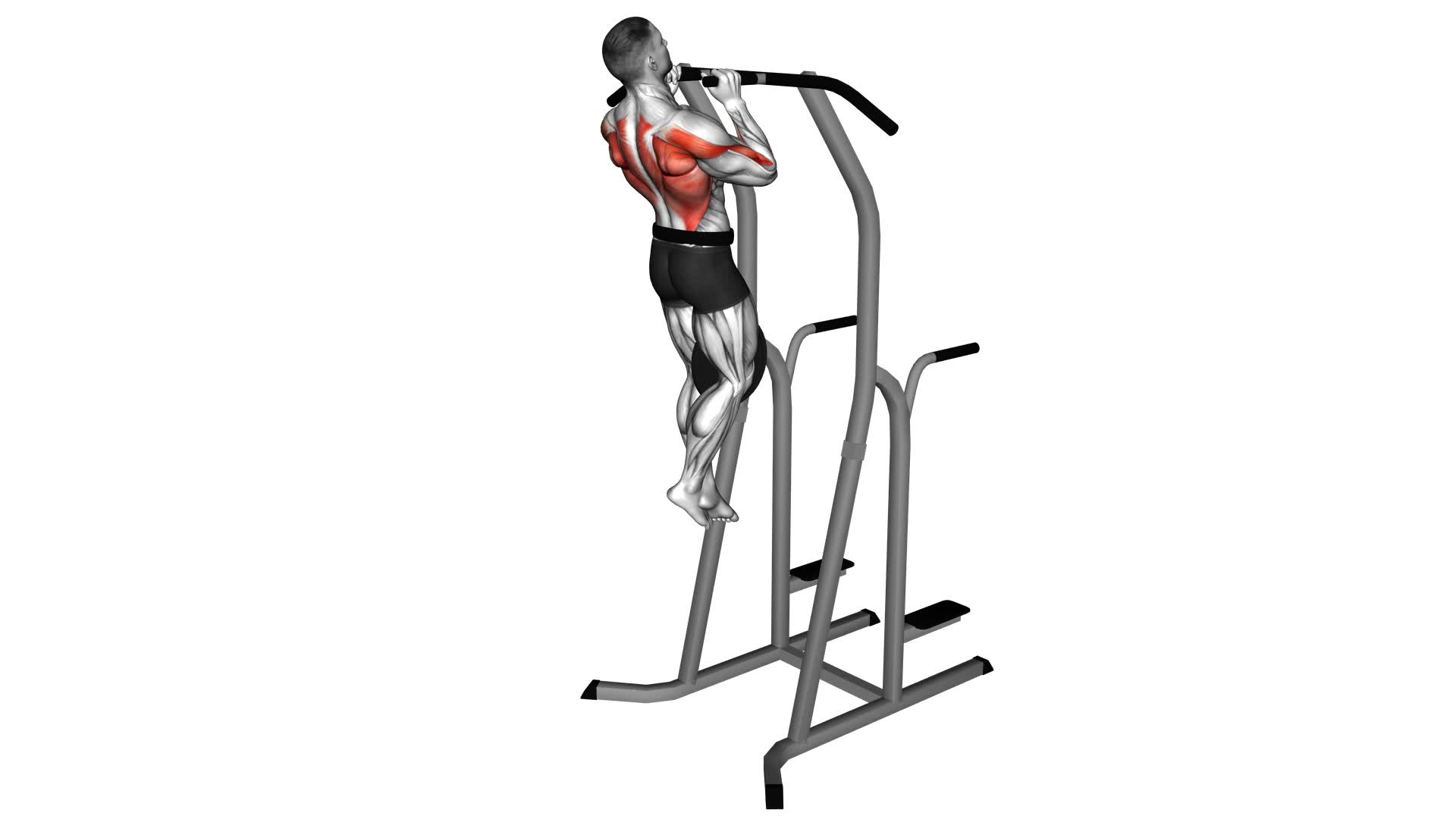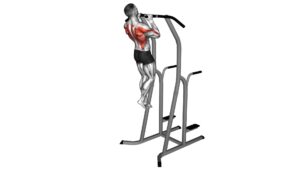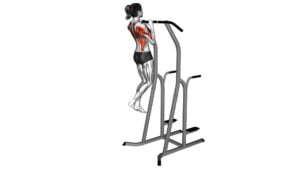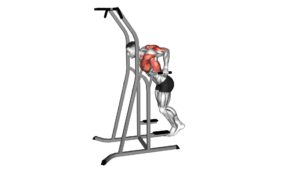Weighted Hammer Grip Pull-up on Dip Cage – Video Exercise Guide & Tips

Are you looking to take your upper body strength to the next level?
Watch This Exercise Video
Then the weighted hammer grip pull-up on the dip cage is the exercise for you.
In this video exercise guide, you'll learn the proper form and technique to maximize your gains.
We'll also share tips and tricks to make your workout more effective and highlight common mistakes to avoid.
Get ready to challenge yourself and achieve new heights with this intense upper body exercise.
Key Takeaways
- The weighted hammer grip pull-up builds stronger back and arm muscles.
- It targets upper body muscles such as the lats, biceps, and shoulders.
- Increasing resistance with weights or bands can lead to greater strength gains.
- Proper form and technique, including keeping elbows close to the body and squeezing shoulder blades together, are important for an effective workout.
Benefits of the Weighted Hammer Grip Pull-up
One major benefit of the weighted hammer grip pull-up is that it helps you build stronger back and arm muscles. This exercise specifically targets the muscles in your upper body, including your lats, biceps, and shoulders. By adding weight to the pull-up, you increase the resistance and challenge your muscles even more, leading to greater strength gains over time. Additionally, the hammer grip variation of the pull-up places less stress on your wrists and elbows compared to the traditional overhand grip. This can be beneficial for individuals who may have wrist or elbow issues.
Furthermore, the weighted hammer grip pull-up offers variations that can be incorporated to further enhance your workout. One variation is the use of resistance bands, which can assist you in completing the exercise if you're unable to do a full pull-up yet. Another variation is the use of a weighted vest or belt to increase the resistance. These variations allow you to adjust the intensity of the exercise based on your fitness level and goals.
In order to maximize the benefits of the weighted hammer grip pull-up, it's important to perform the exercise with proper form and technique.
Proper Form and Technique for the Exercise
To perform the weighted hammer grip pull-up with proper form and technique, you should start by positioning yourself on the dip cage with a double overhand grip on the handles. Make sure your hands are shoulder-width apart and your palms are facing each other. Begin by hanging with your arms fully extended and your shoulders relaxed.
As you initiate the movement, engage your back muscles and pull your body up towards the handles. Focus on keeping your elbows close to your body and squeezing your shoulder blades together at the top of the movement. Aim to bring your chin above the handles while maintaining control and stability throughout the exercise.
It's important to avoid common mistakes such as using momentum to swing your body or arching your back excessively. These errors can diminish the effectiveness of the exercise and increase the risk of injury. Instead, aim for a controlled and smooth movement, focusing on engaging the targeted muscles.
To progress with the weighted hammer grip pull-up, you can start by adding small weights to a weight belt or using a dip belt with a chain. Increase the weight gradually over time to continue challenging your muscles. You can also try different variations, such as using a wider or narrower grip, to target different areas of your back and arms.
Adding Weight and Resistance to Your Pull-Ups
Now let's explore how you can increase the challenge of your weighted hammer grip pull-ups by adding weight and resistance.
There are various weighted pull-up variations you can try to intensify your workout.
One option is to use a weight belt or a weighted vest, which allows you to add extra weight to your body while performing pull-ups. This added resistance will make your muscles work harder and promote strength and muscle growth.
Another alternative exercise for adding resistance to your pull-ups is using resistance bands. Attach one end of the band to the bar and the other end to your feet or knees. As you perform the pull-up, the band will provide resistance, making the exercise more challenging.
If you don't have access to a weight belt or resistance bands, you can also try using a dumbbell or a kettlebell. Hold the weight between your feet or cross your ankles to secure it, then perform the pull-up as usual. This will add resistance and increase the difficulty of the exercise.
By incorporating these weighted pull-up variations and alternative exercises for adding resistance, you can continue to challenge your muscles and improve your strength.
Now, let's move on to the next section where we'll discuss some tips and tricks for a more effective workout.
Tips and Tricks for a More Effective Workout
To make your weighted hammer grip pull-up workout more effective, try incorporating these tips and tricks for maximum results:
- Increase Intensity: Gradually increase the weight or resistance you use during your pull-ups to challenge your muscles and promote growth. Start with a weight that allows you to complete 8-12 reps with good form, and gradually increase the weight as you get stronger.
- Try Variations: Incorporating different variations of the hammer grip pull-up can target different muscle groups and prevent plateaus. Experiment with wide grip, close grip, or mixed grip pull-ups to work different parts of your back and arms.
- Progression Methods: To continue challenging your muscles and making progress, try using progression methods such as negatives or assisted pull-ups. Negatives involve focusing on the lowering portion of the exercise, while assisted pull-ups use a band or machine to provide assistance.
- Focus on Form: Proper form is crucial for an effective workout and reducing the risk of injury. Keep your core engaged, shoulders down and back, and pull yourself up using your back muscles rather than relying on momentum.
Common Mistakes to Avoid During the Exercise
Avoiding common mistakes is crucial for maximizing the effectiveness of your weighted hammer grip pull-up workout. By ensuring proper technique, you not only reduce the risk of injury but also target the intended muscles more effectively.
One common mistake to avoid is using excessive momentum to pull yourself up. It's important to engage your back and arm muscles to perform the movement, rather than relying on swinging or jerking motions.
Another mistake to watch out for is allowing your shoulders to shrug up towards your ears during the exercise. This can put unnecessary strain on your neck and shoulders, and also takes away from the engagement of your back muscles. Keep your shoulders down and back, maintaining a strong and stable position throughout the movement.
Lastly, avoid using a grip that's too wide or too narrow. A grip that's too wide can strain your shoulders, while a grip that's too narrow may limit your range of motion. Find a grip width that feels comfortable and allows you to perform the exercise with proper form.
Frequently Asked Questions
How Many Sets and Reps Should I Do for the Weighted Hammer Grip Pull-Up?
When it comes to the weighted hammer grip pull-up, it's important to consider how many sets and reps you should do. Incorporating weighted pull-ups into your workout routine can have many benefits, such as increased strength and muscle growth.
To start, aim for 3 sets of 8-12 reps, using a weight that challenges you but allows for proper form. As you progress, you can gradually increase the weight and reps.
Remember to always maintain proper form and seek guidance if needed.
Can I Do the Weighted Hammer Grip Pull-Up Without a Dip Cage?
Yes, you can do the weighted hammer grip pull-up without a dip cage. There are alternative equipment options available, such as a pull-up bar or a sturdy overhead beam.
Make sure to maintain proper form throughout the exercise. Hang the weight securely and grip the bar with a hammer grip. Engage your core and pull yourself up until your chin is above the bar.
Lower yourself back down with control.
Is the Weighted Hammer Grip Pull-Up Suitable for Beginners?
The weighted hammer grip pull-up isn't recommended for beginners. It requires a certain level of strength and muscular endurance.
However, if you're a beginner and want to work towards this exercise, there are progressions you can follow to gradually build up your strength. It's important to start with the basic pull-up and focus on proper form.
Common mistakes in the weighted hammer grip pull-up include using momentum and not engaging the muscles properly.
Can I Substitute the Weighted Hammer Grip Pull-Up With Other Exercises?
If you're looking for alternative exercises to the weighted hammer grip pull-up, there are a few options you can try.
Incorporating exercises like lat pulldowns, bent-over rows, or assisted pull-ups can help target similar muscle groups.
However, it's important to note that the weighted pull-up offers unique benefits, such as increased strength and muscle growth.
How Long Should I Rest Between Sets of the Weighted Hammer Grip Pull-Up?
To optimize your muscle recovery during strength training, it's crucial to determine the optimal rest periods between sets of the weighted hammer grip pull-up.
Rest periods can vary depending on your fitness level and goals. However, a general guideline is to rest for about 1-3 minutes between sets.
This allows your muscles enough time to recover and replenish their energy stores. As you progress and increase the difficulty of your weighted pull-up variations, you may need longer rest periods to ensure adequate recovery.
Conclusion
In conclusion, the weighted hammer grip pull-up is a challenging exercise that offers numerous benefits for your upper body strength.
By maintaining proper form and technique, you can effectively target your back, biceps, and shoulders.
Adding weight and resistance can further enhance the intensity of your workout.
Remember to follow the tips and tricks provided to maximize your results and avoid common mistakes.
Incorporate this exercise into your routine for a more effective and well-rounded workout.

Author
Years ago, the spark of my life’s passion ignited in my mind the moment I stepped into the local gym for the first time. The inaugural bead of perspiration, the initial endeavor, the very first surge of endorphins, and a sense of pride that washed over me post-workout marked the beginning of my deep-seated interest in strength sports, fitness, and sports nutrition. This very curiosity blossomed rapidly into a profound fascination, propelling me to earn a Master’s degree in Physical Education from the Academy of Physical Education in Krakow, followed by a Sports Manager diploma from the Jagiellonian University. My journey of growth led me to gain more specialized qualifications, such as being a certified personal trainer with a focus on sports dietetics, a lifeguard, and an instructor for wellness and corrective gymnastics. Theoretical knowledge paired seamlessly with practical experience, reinforcing my belief that the transformation of individuals under my guidance was also a reflection of my personal growth. This belief holds true even today. Each day, I strive to push the boundaries and explore new realms. These realms gently elevate me to greater heights. The unique combination of passion for my field and the continuous quest for growth fuels my drive to break new ground.



